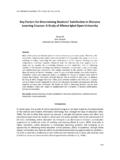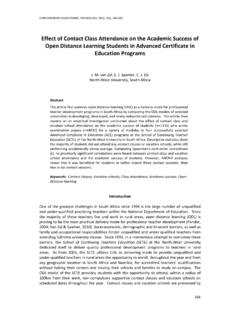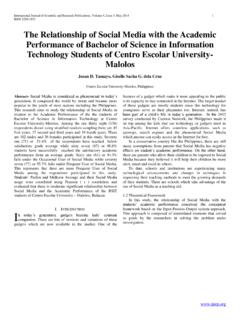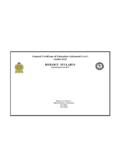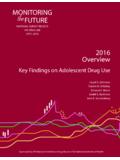Transcription of E-Book versus Printed Materials: Preferences of University ...
1 CONTEMPORARY EDUCATIONAL TECHNOLOGY, 2013, 4(2), 121-135. E-Book versus Printed Materials: Preferences of University Students*. Gonca Cumaoglu, Esra Sacici, & Kerem Torun Yeditepe University , Turkey Abstract Reading habits, accessing resources, and material Preferences change rapidly in a digital world. University students, as digital natives, are accessing countless resources, from lecture notes to research papers electronically. The change of reading habits with a great scale has led to differentiation on accessibility of resources, archiving them and usage of related technologies. The purpose of this study is to examine the E-Book usage Preferences versus Printed material along with reading habits in a context of different variables. Additionally, different uses of e-books in a variety of faculties have been the focus of this study. The participants comprised of 222 students, studying in 36 different universities across Turkey. A. questionnaire was developed specifically for the study.
2 The questionnaire consisted of three parts: Printed book reading habits, E-Book reading habits (methods of reaching e-books, aim of usage etc.), and technological knowledge ( E-Book related tools and file formats etc.). According to the results of study, approximately 68% of University students stated that they read one book in a week and 62% indicated that they are E-Book readers. Moreover, there was a significant relationship between social environment and reading habits of students. University students put forward accessibility advantage (68%) of E-Book and stated that they mostly read E-Book for research (81%). E-Book format which is most commonly preferred among students is Portable Document Format (pdf) (73%), while the computer is the most commonly used E-Book medium (60%). Keywords: E-Book ; Printed material ; Reading Preferences ; Reading habits; University students;. Higher education Introduction In this age we witness that the Printed resources have been replaced with electronic resources and the habits related to newspaper, magazine, course material and book reading have undergone changes.
3 Amongst modern-age college students in particular who were born as digital-natives to the 21st century, these habits demonstrate even further variance. One of the most noteworthy concepts that emerged within this context has been E-Book . A common definition of E-Book was suggested by Armstrong, Edwards, and Lonsdale (2002) as: [ ] any piece of electronic text regardless of size or composition (a digital object), but excluding journal publications, made *. A brief version of this paper was presented at the International Conference on Communication, Media, and Technology (ICCMT'12). 121. CONTEMPORARY EDUCATIONAL TECHNOLOGY, 2013, 4(2), 121-135. available electronically (or optically) for any device (handheld or desk-bound) that includes a screen. During the last 10 years E-Book releases of publishers, E-Book catalogues prepared by University libraries, easy internet access to resources have all together contributed to the spread of E-Book use. Despite the fact that reading from a screen appears to be disadvantageous at first sight, the counter-part advantages such as mobility, saving physical space, convenience, saving time and money, ease-of-use are the primary motivations in preferring e-books (Rosso, 2009).
4 The effect of this transformation from Printed material to e-books on our reading habits is also a subject worthy of deeper analysis. The purpose of this study is to analyze the variables relevant with the E-Book reading habits of University students (the aspects they deem advantageous, related purposes, methods of access, the most frequently used E-Book environment and file formats). Although the reading electronic documents in digital environment are commonly associated with E-Book , it would be beneficial to study this concept along with its software and hardware related aspects. From hardware aspect, the tablets were specifically designed and manufactured for reading e-books along with computers. (eg. Kindle.) Such devices have many advantages due to their mobility, ability to store a large number of books, and its convenience for reading anytime anywhere. As for the software aspect, although the manufacturers of such technology developed their own software and file systems for E-Book reading, there are also common file types that can be used in each device available ( PDF) Apart from software and hardware, the old books are required to be converted to E-Book format as the new books should be published in such format.
5 In this sense, the print houses publishing the books in E-Book format and the University libraries compiling E-Book catalogues, supported the establishment of an E-Book archive and led to the widespread use of E-Book . An announcement of a website, which has the largest book sales network on web, stating that the aforementioned site sold 114 e-books against each 100. hardcopies in 2012, is already sufficient to provide us a general idea regarding how widespread the E-Book is. Literature Review With electronic books becoming widespread, various studies have begun to be carried out about reading habits, digital catalogs, and E-Book device. A vast majority of these studies have focused on University students. This is a foregone conclusion considering that e-books became widespread at first in academic libraries for emergence of electronic journals (Mischo, Norman, Shelburne, &. Schlembach, 2007; Shelburne, 2009). In those studies, the main discussion topics have been the ratio of preference in comparison to Printed materials (Nicholas, Rowlands, Clark, Huntington, Jamali, & Olle , 2008), perceptions related to the advantages of e-books (Cassidy, Martinez, &.)
6 Shen, 2012), effect of e-books on learning (Annand, 2008; Muir & Hawes, 2013; Szapkiw, Courduff, Carter, & Bennett, 2013), library collections and circulation of e-books in academic libraries versus Printed books (Christianson, 2005; Slater, 2009; Sprague & Hunter, 2009; Vasileiou, Rowley, &. Hartley, 2012). 122. CONTEMPORARY EDUCATIONAL TECHNOLOGY, 2013, 4(2), 121-135. In a study examining the E-Book usage patterns of University students ( smail & Zainab, 2005), use and non-use of e-books are determined by several circumstances in a model. This model has four dimensions that interact with each other; technological competencies, users' own cognitive makeup, the level of access to e-books, and the types of function or use made of the e-books. In the study although about 70 % of the participants rate positively on the E-Book service and rate themselves as skilled in Internet use and have positive attitude towards the E-Book service, the level of E-Book use is low (39%). The students become aware of the E-Book service mainly while visiting the University library website.
7 In a study which demonstrated the ratio of E-Book use as 37% (Letchumanan & Tarmizi, 2010) it has been detected that use is basically dependent on access and the students who have no previous familiarity with this technology have no tendency to use e- books either. As manifested by a large-scale survey in UK with the participation of 120 universities (Nicholas, Rowlands, Clark, Huntington, Jamali, & Olle , 2008) acceptance of E-Book use among students is by the ratio of 62%. In a different large-scale survey (N=1547) covering the acceptance and use of e- book 57% of students were found to have used e-books. The remainder of students who provided a negative answer on E-Book use has been basically the ones who are not aware of the availability of this service at University library (Shelburne, 2009). The research has also demonstrated that students view easy-access advantage of E-Book as its primary benefit. A different research (Zhang & Beckman, 2011) in support of these surveys (N=1450) has likewise presented that the use of e- book is rather common with a ratio of 53% amongst University students.
8 Percentages of E-Book usage can be interpreted in different ways in different studies. For example in a study in which the percentage of the non-users of e-books has been 62%, it was concluded that e-books is not preferred to Printed material (Cassidy, Martinez, & Shen, 2012). However in the same study, it was concluded that advantages of electronic style is more valuable though it is not preferred. In this study it was also determined that researchers are not aware of the available electronic resources in the libraries on their own field of study. Another study (Annand, 2008) probing into the preference of e-books over Printed resources and its effect on learning (N=109) has unraveled that students generally prefer Printed materials and as regards learning there is no significant differences between two formats. A different study (Woody, Daniel, & Baker, 2010) parallel to the findings of previous research has also provided the conclusion that as course material , students prefer Printed textbook rather than E-Book (N= 91).
9 In another study (N=538), grades of University students from a course and perceived learning score were compared according to preference of electronic book or Printed resource within the scope of a course. Although there is not a significant difference in the sense of grades as a result of study, perceived learning scores of students who prefer E-Book was higher (Szapkiw, Courduff, Carter, &. Bennett, 2013). Some other studies on e-books investigated circulations of the E-Book as a source of libraries. Christianson (2005) studied the .netLibrary usage of five different academic institutions (Louisiana State University , Auburn University , the University of North Texas, Texas A&M Commerce, and Nunez Community College) in order to grasp the usage patterns of E-Book . The overall results of the study showed that the most popular type of E-Book circulation amongst those institutions, are on the fields of computers, technology, and specific sciences and the least usage is on the catalogues regarding the fields of social sciences such as history and political sciences.
10 123. CONTEMPORARY EDUCATIONAL TECHNOLOGY, 2013, 4(2), 121-135. Slater (2009) conducted a study in the University library of Oakland University that compared the circulation of e-books between the Printed materials and the e-books in the sources of .netLibrary and Safari. One of the most outstanding findings of the study was that while the Preferences of the users in the fields of science/technology were leaning towards E-Book format, the user Preferences on the fields of humanities were in the direction of Printed materials. In a study, conducted in the Library of the University of Idaho (Sprague, Hunter, 2009), E-Book related statistics were dissected by focusing three E-Book providers; Ebrary, NetLibrary, and Books 24 7. Although the highest numbers of titles are available in the fields of Business/Economics, Literature and History, when analyzed from the aspect of usage, it was revealed that the most used E-Book catalogues are from the subjects of Computer Science, Psychology and Religion.

